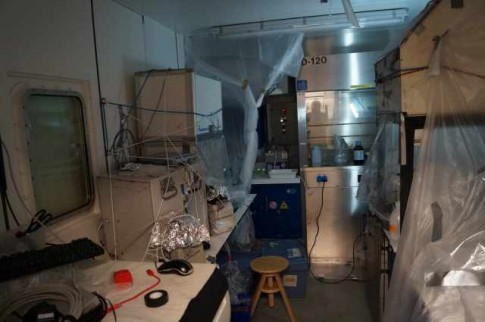 Our satirically named ‘penthouse suite’ is now fully operational. Its ‘stunning’ sea views (a tiny porthole looks out over the ship’s crane), water feature (dripping air conditioning system) and mood lighting (a small lamp in one corner) makes long shifts alone and far away from the action and buzz of the CTD deck incredibly pleasant.
Our satirically named ‘penthouse suite’ is now fully operational. Its ‘stunning’ sea views (a tiny porthole looks out over the ship’s crane), water feature (dripping air conditioning system) and mood lighting (a small lamp in one corner) makes long shifts alone and far away from the action and buzz of the CTD deck incredibly pleasant.
So why are two of us cooped up here for the majority of the next 4 weeks? Well, we have set up flow injection analysis (FIA) systems on board. These are miniaturized, automated laboratories that determine how much of certain chemicals are present in seawater. Jan-Lukas Menzel (GEOMAR) is analyzing dissolved aluminium and Mark Hopwood (GEOMAR) is analyzing iron and hydrogen peroxide. Flow injection systems have the advantage of being able to measure things at sea rather than having to wait until our samples have been shipped back to our home institution in Kiel. This means we have data soon after collecting our samples, so we can tailor our exact research plans based on what we find.
With some components in seawater it is absolutely essential to do quantify them at sea because preservation is either not reliable or simply not possible. For Fe2+ and H2O2 this is especially the case. Both chemicals must be determined immediately after collecting seawater, so our work regime is rather inflexible. A delay of even a few minutes is sufficient for all of the Fe2+ present in a sample of warm surface seawater to oxidize.
Our FIA systems are also very sensitive. The dust plume in the air along the coastline off western Africa is a potent contaminant for our samples so we must work in a container where the air is filtered. Our instruments are additionally set up under laminar flow hoods to prevent any dust that does enter the laboratory from ending up inside our sample vials. The high daytime temperature is also problematic for sensitive FIA systems that have to be precisely calibrated, so an air-conditioned container is essential to run our analysis onboard. The lights are dimmed because Fe2+ and H2O2 are both formed naturally by light, so great effort is made to ensure that we are not accidentally forming more of these chemicals between sample collection and analysis.
Sitting up here for hours on end, day and night, may sound a little lonely. But we have a large collection of music. That, plus the more than ample supply of food onboard prepared and served by our excellent cooks and stewards, should keep us going until Christmas. Additionally we can sleep soundly (and briefly!) in the knowledge that, for us, the cruise ends when the ship docks and our equipment has been offloaded. We will return to spreadsheets full of data from which we can answer questions like how the vast River Congo plume affects the supply of iron and aluminum from Africa to the Atlantic, where hydrogen peroxide in the deep ocean comes from and how sedimentary iron fluxes into the water column change inside oxygen minimum zones. Many of our colleagues on the other hand will have months-years of sample analysis to conduct from just this one cruise.
Hi Jan
wir sind jeden Tag gespannt auf Deinen interessanten Bericht und
Wünschen dem ganzen Team Erfolg und gutes Wetter !
Renate und Heiner